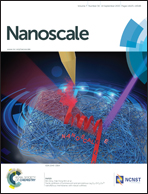Pd nanoparticles encapsulated in magnetic carbon nanocages: an efficient nanoenzyme for the selective detection and multicolor imaging of cancer cells†
Abstract
Rapid and simple molecular recognition based techniques for the identification of the subtypes of cancer cells are essential in molecular medicine. However, improving the sensitivity and accuracy of the early diagnosis of this disease remains a major challenge. Herein, we develop a novel approach for the in situ growth of palladium nanoparticles in magnetic carbon nanocages (PdNPs/MCNCs). The confined Pd NPs, which have excellent dispersion in magnetic carbon nanocages, show superior catalytic performance for the cleavage reaction of N-butyl-4-NHAlloc-1,8-naphthalimide (NNPH), thereby producing significant changes in both color (from colorless to jade-green) and fluorescence (from blue to green) through the ICT process. Based on the abovementioned results, a novel sensing platform utilizing the PdNPs/MCNC nanocatalyst as an artificial enzyme and NNPH as a fluorescent and color change reporter molecule for the multicolor imaging and colorimetric detection of cancer cells was developed. We envision that this nanomaterial can be used as a power tool for a wide range of potential applications in biotechnology and medicine.


 Please wait while we load your content...
Please wait while we load your content...